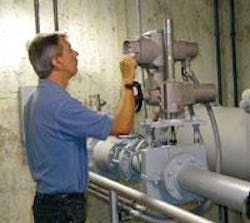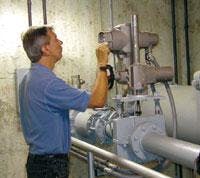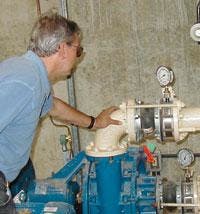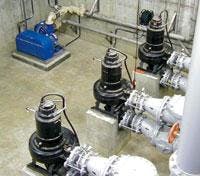Valve System Helps Control Wastewater Flow
Wastewater plant operators are familiar with the normal daily pattern of plant loading. You have a morning and evening peak, a flat trough in between, and then it falls to a trickle throughout the night. Coping with this swing in plant loading is one of the most important determinates of capital spending. Do you size the plant for peak loading or average loading, and how do you cope with the difference between the two?
Burlington Township Central Avenue Sewerage Treatment plant operated traditional trickling filters for processing wastewater. Raw wastewater entered the system through an equalization basin that absorbed excess flow during morning and evening peak periods and fed a constant stream to the filters throughout the day and night. Plant capacity was 1.65 mgd.
An Onyx pinch valve metered the flow between the equalization basin and trickling filters. It was one of the most critical components in the plant since the entire flow stream went through the valve. A malfunction could effectively shut down the entire plant and the quality of the discharged wastewater depended on the ability of the valve to maintain a constant flow through wide range of inlet pressures.
Local development gradually increased flow rates to the point where they threatened to overflow the equalization basin. Township officials hesitated to spend money on replacing the equalization tanks since a new plant was in the early planning stages, but they couldn't tolerate the environmental consequences of having raw sewerage overflow the basin.
Township engineers solved the problem by taking advantage of the close proximity of the much larger Burlington City plant a block away. Instead of replacing the equalization tanks, they diverted part of the flow stream to the Burlington City plant. The city charges the township a fixed rate per gallon for treating sewerage.
Township engineers and plant operators noted that the original pinch valve had proven its performance over half a decade of operation. It maintained a constant flow to the trickling filters with 2 percent accuracy even as the equalization tank level cycled through a level range of 18 feet during each 24-hour period, with zero maintenance and no down time. As a result, they specified a second Onyx pinch valve for the diverter service line.
Onyx Valve Company worked with the Township engineers to select the optimum valve and controls. The company supplied the second valve complete with a control system that included two Moore 352 PID programmable controllers.
These controllers included a 24-hour clock system. Every day a few hours before each peak load period, the controllers would take the time differential of the increase in level. They would automatically calculate the lowest flow rate possible to avoid topping out the basin in order to minimize cost to the township.
The controllers operated in this mode for over five years without missing their target level. They never overflowed the equalization basin and they minimized the treatment bill from the city. The controllers also performed an integration function on the flow meter signal to generate a running total on the number of gallons diverted to verify the accuracy of the city's monthly bill.
The township eventually replaced the trickling filters with a 3.65 mgd Sequential Batch Reactor.
The new Oxidation Ditch, designed by US Filter/Kruger, can absorb a wider range of flow than the old trickle filters so the valve which originally controlled the flow into the plant was no longer needed. However, the township specified the installation of a new diverter pinch valve connecting the township and Burlington City plants. This valve provides them with the ability to clip off a fraction of the peak flow into the township plant one or two hours per day. This enabled the township to install a smaller system, dramatically reducing the capital cost of the new Oxidation Ditch system.
The new plant uses six 100 HP pumps to move wastewater into and out of the sequential batch reaction process. In order to monitor the performance of these critical components, US Filter / Kruger equipped each pump with Onyx isolator rings with gauges on suction and discharge.



